|
The
|
||||||||||||||||||||||||||||||||||||||||||||||||||||||||||||||||||||||||||||||||||||||||||||||||||||||||||||||||||||||||||||||||||||||||||||||||||||||||||||||||||||||||||||||||||||||||||||||||||||||||||||||||||||||||||||||||||||||||||||||||||||||||||||||||||||||||||||||||||||||||||||||||||||||||||||||||||||||||||||||||||||||||||||||||||||||||||||||||||||||||||||||||||||||||||||||||||||||||||||||||||||||||||||||||||||||||||||
THE BURGENLAND BUNCH NEWS - No. 237 November 30, 2013, © 2013 by The Burgenland Bunch All rights reserved. Permission to copy excerpts granted if credit is provided. Editor: Thomas Steichen (email: tj.steichen@comcast.net) Our 17th Year. The Burgenland Bunch Newsletter is issued monthly online. It was founded by Gerald Berghold (who retired Summer 2008 and died in August 2008). |
||||||||||||||||||||||||||||||||||||||||||||||||||||||||||||||||||||||||||||||||||||||||||||||||||||||||||||||||||||||||||||||||||||||||||||||||||||||||||||||||||||||||||||||||||||||||||||||||||||||||||||||||||||||||||||||||||||||||||||||||||||||||||||||||||||||||||||||||||||||||||||||||||||||||||||||||||||||||||||||||||||||||||||||||||||||||||||||||||||||||||||||||||||||||||||||||||||||||||||||||||||||||||||||||||||||||||||
| Current Status Of The BB: * Members: 2201 * Surname Entries: 7313 * Query Board Entries: 5232 * Staff Members: 17 |
||||||||||||||||||||||||||||||||||||||||||||||||||||||||||||||||||||||||||||||||||||||||||||||||||||||||||||||||||||||||||||||||||||||||||||||||||||||||||||||||||||||||||||||||||||||||||||||||||||||||||||||||||||||||||||||||||||||||||||||||||||||||||||||||||||||||||||||||||||||||||||||||||||||||||||||||||||||||||||||||||||||||||||||||||||||||||||||||||||||||||||||||||||||||||||||||||||||||||||||||||||||||||||||||||||||||||||
This newsletter concerns: 1) THE PRESIDENT'S CORNER 2) ST. ALBANS' LISTS 3) THE OSZTOVICS FAMILY STUMP REVISITED (by Joy Minns) 4) BURGENLAND DNA METRICS (by Frank Paukowits) 5) PROPER PEASANTS 6) HISTORICAL BB NEWSLETTER ARTICLES: - VIENNESE ORPHANS IN THE BURGENLAND 7) ETHNIC EVENTS 8) BURGENLAND EMIGRANT OBITUARIES (courtesy of Bob Strauch) |
||||||||||||||||||||||||||||||||||||||||||||||||||||||||||||||||||||||||||||||||||||||||||||||||||||||||||||||||||||||||||||||||||||||||||||||||||||||||||||||||||||||||||||||||||||||||||||||||||||||||||||||||||||||||||||||||||||||||||||||||||||||||||||||||||||||||||||||||||||||||||||||||||||||||||||||||||||||||||||||||||||||||||||||||||||||||||||||||||||||||||||||||||||||||||||||||||||||||||||||||||||||||||||||||||||||||||||
1) THE PRESIDENT'S CORNER (by Tom Steichen)  After
the Bits and Pieces in my President's Corner below, we continue with
our main articles, including one provided by BB member Joy Minns and another by BB staff member,
Frank Paukowits. After
the Bits and Pieces in my President's Corner below, we continue with
our main articles, including one provided by BB member Joy Minns and another by BB staff member,
Frank Paukowits. First, a request for information by new BB member Claudia Freiler of Hornstein, Burgenland, prompted me to do a bit of research into the immigration record sets known as St. Albans' Lists. If you think your emigrant ancestors may have arrived in the US via a Canadian port, you should become familiar with these Lists. Even if not, read the introductory section of the article to see if you have a needed clue for Claudia! Following
that article, Joy Minns tells us about her visit to Allersgraben,
where she had the pleasure of having a village native give her the history of the town where her
Ostovics family once lived.
Looking at the forces involved in the Battle of Mogersdorf gives us lots of choices where a
soldier could have come from.
[Richard continues...] The location of the earliest use of a surname isn’t close to
proof of origin, but it is fun to make a best guess too. Even though the LDS International
Genealogical Index (IGI) covers just a few percent of early birth records it may be the best
place to check... if you know of an interested BB member the research might be worth an article.
I always enjoy the immigration to Burgenland articles in the newsletter. |
||||||||||||||||||||||||||||||||||||||||||||||||||||||||||||||||||||||||||||||||||||||||||||||||||||||||||||||||||||||||||||||||||||||||||||||||||||||||||||||||||||||||||||||||||||||||||||||||||||||||||||||||||||||||||||||||||||||||||||||||||||||||||||||||||||||||||||||||||||||||||||||||||||||||||||||||||||||||||||||||||||||||||||||||||||||||||||||||||||||||||||||||||||||||||||||||||||||||||||||||||||||||||||||||||||||||||||
2) ST. ALBANS' LISTS New BB member Claudia Freiler, of Hornstein, Burgenland, writes that she is trying to discover relatives of Franziska Egger/Eger, the older sister of her great-grandfather, Michael Egger, both originally from Pamhagen in Burgenland. Franziska emigrated at age 18 in 1909, when Michael was 6, but no one now knows where she went or what happened to her. Claudia's interest in Franziska was sparked when she learned that her grandmother (Michael's daughter) was visited a few years ago by some Americans searching for descendants of Michael. However, no one else in Claudia's line was able to meet these Americans and Claudia would like the opportunity to correct that and get to know her relatives. With a little online digging at FamilySearch.org, we were able to find out that Franziska was baptized 12 Nov 1890 in Pamhagen, child of Mathias and Elisabeth (Kotzenmacher / Thüringer) Egger/Eger. Siblings Antonius (born 1888) and Antal (born 1894) were also in the online indexed Pamhagen church records (and Michael is in the scanned civil records). Claudia also found a passenger list that showed that Franziska was on a ship to Quebec in 1909 and later crossed the border from Canada into the US. However, she was unable to get more details. This leads to her request: If you recognize this story or know anything about Franziska and her descendants, please write to me so I can connect you to Claudia. However, this article does not end here because the information we do know about Franziska's arrival and border crossing appears in the "St. Albans' Lists," and these Lists deserve some elucidation. The St. Albans' Lists are the equivalent of the immigration records the US kept on immigrants arriving at US ports, except these are for people who arrived at Canadian ports and then crossed the border into the US. However, the Lists do not start until 1894. Prior to that, no US immigration officer met these immigrants or recorded information about their arrival in the United States. In the mid-1800s, there were immigrants to Canada, but few crossed into the US. However, when the United States began to impose more stringent immigration rules at its ports of entry in the 1880s, more immigrants chose to travel to the US via Canada in order to avoid US immigration inspections or its quota restrictions. By the 1890s, steamship companies were openly advertising passage through Canada as a more desirable route for immigrants who wished to avoid entry problems into the US. This forced the United States to create a system to document and control the many thousands entering via its northern border. In 1894, the US Immigration and
Naturalization Service (INS) (then called the Bureau of Immigration) entered into an
agreement with the Canadian government, and also with the railroads and steamship lines serving
Canadian ports of entry, to bring US-destined immigration into compliance with US law. The
steamship lines agreed to treat all passengers passing through to the United States as if
they were landing at a US port of entry. This meant completing a US ship passenger manifest form
and selling tickets only to those who appeared admissible under US law. Canadian railroads
agreed to carry to US destinations only those immigrants who were legally pre-admitted to the
United States.
Most immigrants from Europe would be found in M1464.
While these are called Soundex Indexes, in actuality they are transcriptions of nearly all
available information on the manifest lists to manifest cards, which were then filed by
Soundexed surname.
If you wish to search these records, a good place to start is the
available online indexes: |
||||||||||||||||||||||||||||||||||||||||||||||||||||||||||||||||||||||||||||||||||||||||||||||||||||||||||||||||||||||||||||||||||||||||||||||||||||||||||||||||||||||||||||||||||||||||||||||||||||||||||||||||||||||||||||||||||||||||||||||||||||||||||||||||||||||||||||||||||||||||||||||||||||||||||||||||||||||||||||||||||||||||||||||||||||||||||||||||||||||||||||||||||||||||||||||||||||||||||||||||||||||||||||||||||||||||||||
3) THE OSZTOVICS FAMILY STUMP REVISITED (by Joy Minns) 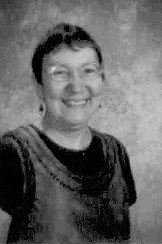 Just
about a year ago, I wrote an article about the research I had started into my dad’s family tree.
In just a few months I had gone from no knowledge beyond my grandparents to quite a bit of
information going back several generations. I still had a lot of unanswered questions, even
about my grandparents’ generation. Who was this Uncle Karl that was never mentioned? I
suspected he had either died as an infant or was a family Black Sheep. And who was the
mysterious Uncle William (Vilnos) who came to America with his parents and
siblings and who was never spoken of? Just
about a year ago, I wrote an article about the research I had started into my dad’s family tree.
In just a few months I had gone from no knowledge beyond my grandparents to quite a bit of
information going back several generations. I still had a lot of unanswered questions, even
about my grandparents’ generation. Who was this Uncle Karl that was never mentioned? I
suspected he had either died as an infant or was a family Black Sheep. And who was the
mysterious Uncle William (Vilnos) who came to America with his parents and
siblings and who was never spoken of?My aunt passed away last summer and my cousin found a box filled with old pictures and postcards. Knowing that I was working on the family history, he sent this box to me. What a treasure trove of information! There were quite a few pictures and cards from Uncle Karl. What a surprise this was—but why was he never mentioned? He was obviously close to my grandfather. 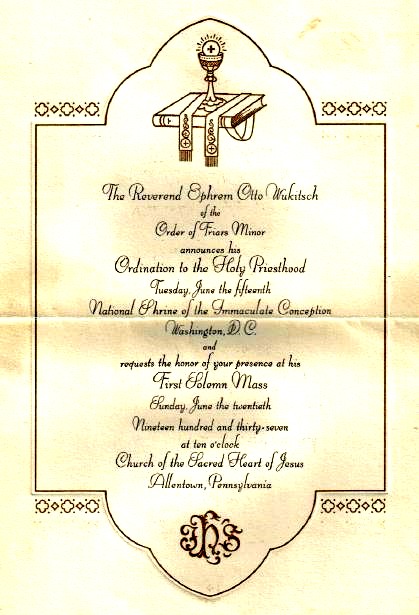 There
were labeled photos of other relatives but I still am not sure where they fit into the picture.
One surprise was an invitation to the ordination of a cousin, Ephrem Wukitsch, of Allentown, PA.
Again, I had no clue that my family had any contact with these cousins or that they even knew
that others of the family had come to the US. I’ve learned quite a bit about Uncle William
also, and he was, indeed, a Black Sheep. I won’t go into his story! There
were labeled photos of other relatives but I still am not sure where they fit into the picture.
One surprise was an invitation to the ordination of a cousin, Ephrem Wukitsch, of Allentown, PA.
Again, I had no clue that my family had any contact with these cousins or that they even knew
that others of the family had come to the US. I’ve learned quite a bit about Uncle William
also, and he was, indeed, a Black Sheep. I won’t go into his story!In mid-October, I decided to take a solo trip to Austria. I wanted to do more research at the Catholic Archives in Eisenstadt and to rent a car and visit Allersgraben, Neumarkt im Tauchental, and Weiden bei Rechnitz. I wanted to travel alone so I wouldn’t feel guilty about spending lots of time doing research while someone else sat idly by, bored to tears. I was a bit nervous about making this trip and my family was adamantly opposed. I tend to get lost driving in my own small town and rarely notice landmarks that might help me find my way around. In spite of their objections, I booked the flight and hotels and headed off to Vienna. I will admit that, had I not been able to speak German, the trip would have been a disaster. I got lost heading from the subway to my Vienna hotel—one at which I’ve now stayed 3 times. This did not bode well. I bought a round-trip train ticket to Eisenstadt and headed out on Monday morning. Since I had been to the Archives once before, I knew it was a straight shot up Bahnstrasse and managed to find the site with little trouble. I worked several hours and then my rolling suitcase, my city plan, and I headed uphill toward my hotel. A half-hour later I had not arrived at my destination and was getting worried but I did eventually arrive at Hotel Haydn. I soon learned that my High German and Burgenländisch were two totally different languages. 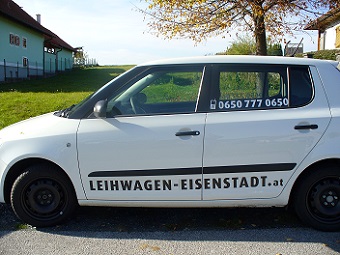 My
first task the following morning was finding the car rental agency in town. City plan in hand, I
bumbled my way through town and finally had to ask for help. I eventually found the place,
signed the contract, and begged for a GPS for the car. Since the people at the car rental place
had no clue where Allersgraben was located, I felt doom approaching quickly. The following
morning I was picked up to be delivered to my waiting rental car. As my family expected, my pick
up was late because I was waiting in the wrong spot—not an auspicious start to the day. I was
more than thrilled to learn that the rental folks had purchased a GPS for my use and let me use
it for 10 Euros extra. They programmed it with “home” so that they would get their car back even
if I never found Allersgraben. Somehow I got the impression they weren’t overly confident
either. They put a 700€ hold on my credit card in case I caused an accident. They were somewhat
impressed, however, that I could drive a standard shift, and that’s a good thing since all of
their cars (and most cars in Europe) are standard. My
first task the following morning was finding the car rental agency in town. City plan in hand, I
bumbled my way through town and finally had to ask for help. I eventually found the place,
signed the contract, and begged for a GPS for the car. Since the people at the car rental place
had no clue where Allersgraben was located, I felt doom approaching quickly. The following
morning I was picked up to be delivered to my waiting rental car. As my family expected, my pick
up was late because I was waiting in the wrong spot—not an auspicious start to the day. I was
more than thrilled to learn that the rental folks had purchased a GPS for my use and let me use
it for 10 Euros extra. They programmed it with “home” so that they would get their car back even
if I never found Allersgraben. Somehow I got the impression they weren’t overly confident
either. They put a 700€ hold on my credit card in case I caused an accident. They were somewhat
impressed, however, that I could drive a standard shift, and that’s a good thing since all of
their cars (and most cars in Europe) are standard. Austria is the land of traffic circles, something that I especially hate. I encountered one right away and then lost my way briefly after taking a wrong turn off another. I did make it successfully to the booming town of Allersgraben. The original 12 homes now number up to 18. I parked and started walking. ![Allersgraben, Austria [looking toward the East]](237/o_allersgraben.jpg) My grandfather’s home, #1, is still standing and is now an art gallery of sorts. [Ed. note: House #1 is U-shaped, with gray and reddish roofs, on the far side of the road, second from the far right in the picture above.] House #2, my grandmother’s, is no longer there. I walked down the street and saw a man working near his barn at house #7. I walked down the drive and got his attention, told him who I was and why I was there. He put down his chain saw and started talking. At first I understood little but I gradually caught on to the dialect. He started with Genghis Khan, went on to the Wallachians, the Turks, and the history of Allersgraben. How did I manage to luck upon the one person in the village who knew the history of the area so well?! Mr. Ruck was able to tell me who had inhabited the town prior to the arrival of the Osztovics family in 1660, about a farmhand who had burned my grandfather’s house down in 1891, and how the house was rebuilt with stone. He pointed out the town cemetery up on a hill above the chapel. Mr. and Mrs. Ruck insisted that I stay for lunch. They were preparing for a Heurigen festival the next night and Mr. Ruck gave me a sample of his singing and accordion playing. 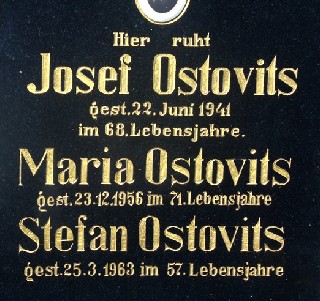 I
walked up to the cemetery and took pictures of the headstones. Since then, I’ve been matching
names with my notes. Mr. Ruck spread word of my visit throughout town and I received an email
from a villager who said he had inherited the land where my grandmother’s house stood. I was
able to figure out that he’s my second cousin! I
walked up to the cemetery and took pictures of the headstones. Since then, I’ve been matching
names with my notes. Mr. Ruck spread word of my visit throughout town and I received an email
from a villager who said he had inherited the land where my grandmother’s house stood. I was
able to figure out that he’s my second cousin!I worked for about 16-18 hours at the Archives during the week. The really old books were written in Latin and the information went from being quite sketchy—date of death, name of deceased—to quite informative just a few pages later. At times, the death records gave the names of both parents, the age of the person, the cause of death, and the town where the family resided. Things were written phonetically in the records of the 16- and 1700’s: a last name or the name of the town would be spelled many different ways. As the 1700’s went by, the language changed to Hungarian. Again the format of the information went from sketchy and messy to very organized and neat. The records I liked best were when the priest did a grid so that all of the information was uniform. Marriage records were most helpful because that was the only place you will find a bride’s maiden name. The last names of mothers were rarely recorded until the late 1700’s. The differing styles of handwriting over the years can be a real hindrance to understanding the information also. After 1920, the language switched to German and most records were kept in a nice grid format.  What is my point here? I went from knowing absolutely nothing about the Hungarian language or about genealogy research to feeling almost “expert” in the space of less than a year and a half. The people I met in the Burgenland were friendly and helpful and it’s possible that I would have gotten by without my knowledge of German. Even if you are not blessed with “dog with a bone syndrome” (otherwise known as hard-headed Ostovitz syndrome), take the plunge and give it a try! |
||||||||||||||||||||||||||||||||||||||||||||||||||||||||||||||||||||||||||||||||||||||||||||||||||||||||||||||||||||||||||||||||||||||||||||||||||||||||||||||||||||||||||||||||||||||||||||||||||||||||||||||||||||||||||||||||||||||||||||||||||||||||||||||||||||||||||||||||||||||||||||||||||||||||||||||||||||||||||||||||||||||||||||||||||||||||||||||||||||||||||||||||||||||||||||||||||||||||||||||||||||||||||||||||||||||||||||
4) BURGENLAND DNA METRICS (by Frank Paukowits) We have begun to analyze the data from our Burgenland DNA project, which now has close to 100 participants. Essentially, the data was analyzed from three perspectives: 1) the incidence of participants by region (that is north versus south Burgenland) based on haplotypes; 2) the distribution of participants by haplotype and by surname origin; and 3) the breakdown of participants by ethnic affiliation based on haplotype groupings. North versus South Burgenland What is particularly noteworthy is the number of participants from south Burgenland (that is, from the Güssing, Jennersdorf and Oberwart Bezirks) versus the rest of Burgenland, which for the purposes of this study was considered northern Burgenland. Currently there are 64 participants from the south compared to only 24 from the north (the geographical origin of six of the participants was unknown). This mix is not surprising, since it is believed this represents the distribution of the Burgenland Bunch membership from which our sample was mostly drawn. The overall population represents a cross section of many different haplotypes, which parallel the mix of people living in Burgenland. However, what jumps out is the percentage of participants in the north (45.5%) of German or Italo-Celtic origin. That number was just about double the number in the South. Conversely, there was a reasonably large grouping of Slavic (Croatian) DNA in the south versus the north. There were eight participants in the south with Slavic (Croatian) DNA and none in the north. Yet, we know for a fact that there are Croatian towns in the north, but emigration from these towns is said to have been noticeably lower than emigration from German towns in the north. This phenomena, in part, could account for the differences we found. Following is a table that highlights this information:
Surname Origin
Ethnic Affiliation
Understandably, those participants that ended up in German-related haplotypes had German
surnames by large margins. More than 80 percent of the people in German-related haplotypes had
German surnames compared to less than 10 percent for participants with Hungarian and Slavic
surnames. The converse was true in the Slavic / Hungarian category where Hungarians and Slavs
predominated in relation to the percentage of participants who had DNA tests done. |
||||||||||||||||||||||||||||||||||||||||||||||||||||||||||||||||||||||||||||||||||||||||||||||||||||||||||||||||||||||||||||||||||||||||||||||||||||||||||||||||||||||||||||||||||||||||||||||||||||||||||||||||||||||||||||||||||||||||||||||||||||||||||||||||||||||||||||||||||||||||||||||||||||||||||||||||||||||||||||||||||||||||||||||||||||||||||||||||||||||||||||||||||||||||||||||||||||||||||||||||||||||||||||||||||||||||||||
5) PROPER PEASANTS 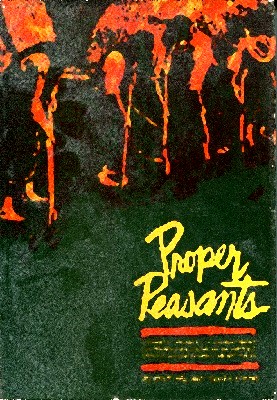 Some
time ago, based on a recommendation from Fritz Königshofer, I acquired a copy of a book titled
"Proper Peasants: Traditional Life in a Hungarian Village." The authors are Edit Fél and
Tamás Hofer, two Hungarian ethnographers (social scientists who specialize in the branch of
anthropology that deals with the scientific description of specific human cultures). The
hardcover book was published (in English) by Aldine Publishing Co., Chicago, in 1969, and
consists of 440 7" x10" pages of text, diagrams and photographs; it is a large,
information-filled volume. Some
time ago, based on a recommendation from Fritz Königshofer, I acquired a copy of a book titled
"Proper Peasants: Traditional Life in a Hungarian Village." The authors are Edit Fél and
Tamás Hofer, two Hungarian ethnographers (social scientists who specialize in the branch of
anthropology that deals with the scientific description of specific human cultures). The
hardcover book was published (in English) by Aldine Publishing Co., Chicago, in 1969, and
consists of 440 7" x10" pages of text, diagrams and photographs; it is a large,
information-filled volume.My lightly-used copy was acquired through Amazon Books for $8.21 ($12.20, including shipping, etc.). In checking Amazon today (Oct 2013), I see they have hardcover copies available starting at $6.60 and paperback copies at $4.73 (this book is a major bargain at those prices!). There is also a 2008 edition, re-titled "Proper Peasants: Social Relationships in a Hungarian Village," now with 473 pages but, otherwise, according to the provided description, appearing to be a only a minimal update/extension of the earlier volume. I do not have a copy of this version so cannot say exactly what differences might exist. These start at $16.76 for used paperback copies and $50.27 for new paperbacks. My intention, over a number of articles, starting in this and then later in various upcoming newsletters, is to describe those details that might enlighten us on how our Burgenland ancestors lived and interacted with their fellow citizens. I must, however, immediately give the caveat: the book studies a village some 70 miles east of Budapest that is on the northern edge of the eastern Great Hungarian Plain (the Alföld), far from Burgenland's more-varied terrain, whose people were almost exclusively ethnic Hungarians (Magyars) of the Calvinist faith, as opposed to Burgenland's mixed but ethnic-German-dominated peoples who were predominantly Catholic. Nonetheless, this village and our Burgenland villages were all under Hungarian rule (and rules) during the time of interest and all experienced the great upheavals of the Austro-Hungarian empire and the social changes of the times. While I believe part of the social/economic culture described in the book is unique to its selected village and people, I also believe much of the culture is universal to the larger time and place and is applicable to our ancestors. Fritz Königshofer, when he recommended the book to me, also suggested it had sufficient universal nature to make it applicable to Burgenland during its Hungarian time. In the rest of this article, I will give details about the village and the methodology of the study. Subsequent articles in other newsletters will concentrate on specific aspects of the cultural behaviors and interactions in the village. In all articles, I will attempt to compare with Burgenland, pointing out differences and similarities where appropriate. So, here goes... The village studied is Átány, Heves County, Hungary. Its population remained relatively constant from the mid-1800s until 1930, at which time its population was ~3000; since then, it has steadily declined towards its current population of ~1500. During the 14 years of the study reported in the text (1951-1965), the total population stood at ~2600, with ~2000 residents being Reformed (Calvinist), and with ~500 Catholics, ~50 Jews, and 50-180 Gypsies depending on the particular year. The only church in town was Calvinist, though the surrounding region was Catholic-dominated. The only mentions of "non-Magyar" residents is in reference to the Gypsies. 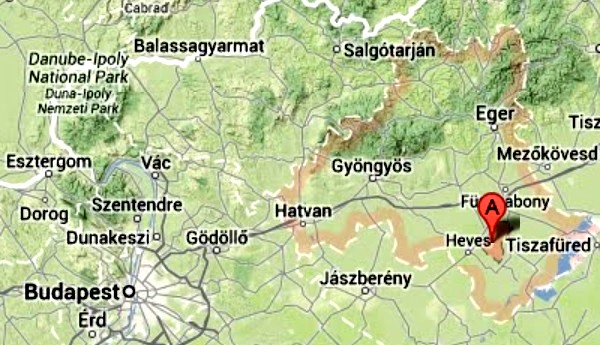 Átány
lies in the southern, great plains region of Heves County, near the Tisza River. Eger, the
county seat, lies to the north in the foothills of the Mátra and Bükk mountain ranges, which
dominate the northern third of the county. While Átány had some limited commerce with the
mountainous regions, the county seat, and beyond the Tisza, its routine daily interactions
seldom went beyond the nearest surrounding villages and the district seat of Heves. One
exception was to find suitable Calvinistic spouses, for those villages were more widely spread. Átány
lies in the southern, great plains region of Heves County, near the Tisza River. Eger, the
county seat, lies to the north in the foothills of the Mátra and Bükk mountain ranges, which
dominate the northern third of the county. While Átány had some limited commerce with the
mountainous regions, the county seat, and beyond the Tisza, its routine daily interactions
seldom went beyond the nearest surrounding villages and the district seat of Heves. One
exception was to find suitable Calvinistic spouses, for those villages were more widely spread.Átány was chosen for study, in large part, because it was insular and had retained the traditional way of life more so than most Hungarian villages. In fact, the book title, "Proper Peasants," was chosen because it was the phrase by which Átány people proudly referred to themselves, and indicated that Átány people had "properly" retained traditional peasant characteristics in their way of life. As such, the community allowed the ethnographers to reach "further into the past" than they could do elsewhere. The researchers explicitly chose the village because they believed it would allow examination of social institutions and patterns of interpersonal relationships closer to that of ancient peasant culture and they chose to concentrate and report mostly on the "more antiquated" features. The basic "research method" consisted of visits of four to twelve days at a time by one or both authors, each of whom was an guest within a separate Átány host family; the two host families differed significantly in social status. In total, the authors spent about 500 days in the village over the first 12 years, with each visit having a definite purpose: participation in a certain type of work, at a festival, or in a family event, or collection of interview material on a particular topic. Having one male and one female investigator proved advantageous, as rules of propriety in the village often admitted the presence of only a specific gender. Their status within the village was twofold: esteemed and more or less official guests of the whole village, thus having extensive access to the civil and ecclesiastical leaders of the village and in community-wide affairs; and participants within a specific family unit, thus included in the relationships of kinship, friendship, neighborhood, etc. of these families. In addition, the researchers developed 11 "principal informants" among the village members. These informants spanned the social classes of the village, tended to be older with deep roots in the village, and were both interested in and well informed about the village history and people. They knew—and shared—much of the oral history of the village. Lastly, the village had a local historical museum, so was rich in written sources of material on life in the village from past decades and centuries. These included journals from local village councils, church records, registries of births marriages and deaths, records of public and manorial administration, tithe collection records, registries of the earlier jobbágy (serf) population and their possessions and obligations, criminal records and land registries. From the Hungarian Central Statistical Office, there were also data on the population and local economy going back to the mid-1800s. Without question, the basic economy of the village was subsistence farming. Like Burgenland villages, Átány had a central village surrounded by its farmland and outbuildings. These combined land areas were known as the határ (in Burgenland, the similar German term is hotter) and consisted of 9,172 holds (13,024 acres; 20.35 sq. miles). In 1935, there were 715 farms within the határ, giving an average size of 12.8 holds (18.2 acres), however, this average was skewed high by a small number of very large farms (manorial farms, church holdings, community land, land lords, etc.). The following table shows that over half of the "farms" in 1935 consisted of less than 5 holds and the most "affluent" peasant farmers controlled only 20 to 100 holds (28 to 142 acres), with almost 90% of them controlling 50 holds (71 acres) or less.
However, the authors note that Átány's distribution of very small and very large
holdings is actually less severe than in the surrounding area. That is, there are
proportionally less of these than seen elsewhere; thus Átány is more "middle class" than typical
for the area, with fewer very poor and fewer very rich (as least as measured by land holdings).
In the Lackendorf tax data, holdings of husbands and wives were separately
listed, but I have aggregated them for this table. Further, where separate tracts were held by a
person with the same name and house number, I have aggregated these also. |
||||||||||||||||||||||||||||||||||||||||||||||||||||||||||||||||||||||||||||||||||||||||||||||||||||||||||||||||||||||||||||||||||||||||||||||||||||||||||||||||||||||||||||||||||||||||||||||||||||||||||||||||||||||||||||||||||||||||||||||||||||||||||||||||||||||||||||||||||||||||||||||||||||||||||||||||||||||||||||||||||||||||||||||||||||||||||||||||||||||||||||||||||||||||||||||||||||||||||||||||||||||||||||||||||||||||||||
6) HISTORICAL BB NEWSLETTER ARTICLES Editor: This is part of our series designed to recycle interesting articles from the BB Newsletters of 10 years ago. This month, I reprint one from Newsletter No. 123B (November 30, 2003), concerning Viennese orphans raised in Burgenland. Last month, I included an article asking where Burgenländers lived in Vienna, in hopes we might be able to help descendants search out the proper birth record. This article is much the reverse... a story of how non-Burgenländers ended up (and often died) in Burgenland. THE BURGENLAND BUNCH NEWS No. 123B November 30, 2003 VIENNESE ORPHANS IN THE BURGENLAND (from Fritz Königshofer) ED. [Gerry Berghold] Note: some time ago when I was scanning Burgenland church death records of southern Burgenland, I found a number of entries reporting deaths of young children. They all included the fact that they were born in Vienna and they all had a cryptic number as part of their record. They died at various village locations and their death was reported by local villagers. Often, there would be notes in Hungarian or German, the drift of which indicated that they were orphans under the care of locals. We have mentioned these before, but it is very possible that our members may find such an orphan in their family history. A message about these orphans appeared on the Burgenland query board and received the following answer from Fritz Königshofer: Information Concerning Viennese Orphans: Since after the uprising of 1848, and even more so after the Compromise with Hungary in 1867, Vienna started to thrive as the capital of the Austrian Empire, I assume that many people flocked to Vienna from all parts of the dual Monarchy in the pursuit of work. There were many single young women among them who tried to get jobs as chamber maids, nurses, cooks, maids for everything (Mädchen für Alles, often abbreviated MfA), etc. It must have happened frequently that these women bore children out of wedlock. Add to that the children born to prostitutes who also congregated in the metropolis of Vienna, hailing from all parts of Empire and Kingdom. Perhaps there were too many babies and children to take care of by the "Niederösterreichische Findlinganstalt" (Foundlings Institute of Lower Austria). Therefore, apparently, an attempt was started to place these children with foster families in rural areas of the Monarchy. While they were called foundlings and orphans, the mothers were often known, but not able to care for the children, and there must have been too many of these babies to find adoptive parents for them. Children were placed with people ostensibly willing to take them into foster care, in Bohemia, the Hungarian counties of Pozsony and Nyitra, and possibly other regions. From about the 1870/1880s onwards, children were apparently also placed in Western Vas county, mostly the upper Raab and the Lafnitz valley, from Jennersdorf to Felső Rönök. The conditions may have differed over the years, and may have differed between regions, but families received about 6 florins per month per child, and the children had to be returned to the Institute in Vienna after reaching age 6 to 12. The unfortunate fact was that very few people with food on the plate took these children into foster care. Mostly, the volunteers were people or families with no money to feed themselves, and no land or milk-producing livestock. Almost a trade developed, where some shrewd (though irresponsible) people collected orphans in Vienna, took the advance payment for the foster care for one year, then traveled with the children to their rural home areas where they placed the poor children with unsuited foster families or persons, taking a cut on the advance money received for the foster care. When one reads the death records of that time (till the early 20th century) of the Raab valley in former Vas county, one can easily get dispirited by the many deaths reported among the foster children, usually mostly born in Vienna, but some in Graz too. In many parishes, these deaths outnumbered deaths in the local population (children to adults) by 2 to 1. The cruelty and abuse did, however, not go unnoticed. Local people with a heart complained to newspapers about the Institute in Vienna and the local abusers who essentially starved their children to death. The Institute in Vienna, itself, was aware of the problems and, at least at times, tried to address them. Despite the bad odds, some of the children managed to survive their ordeals and stay with sometimes loving foster families or return to Vienna and Graz to start an apprenticeship. Most of the information I just conveyed, I owe to Albert Schuch, who serves as the Austrian editor of the Burgenland Bunch (BB) Newsletter. You can find a few articles on the Vienna orphans in BB newsletters 58B of May 31, 1999, and 91A of December 31, 2000. 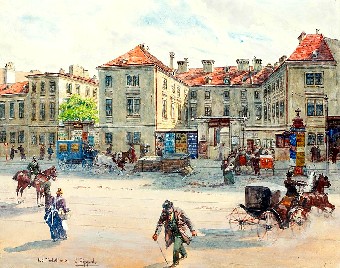 Editor:
The Vienna Foundlings and Orphans Home, at 23 Alserstrasse, Wien VIII, was
established in 1784 by Emperor Joseph II and remained open until 1910. Its primary aim was to
protect the newborn from abandonment or infanticide and to protect the mother and child by
providing birth under medical supervision. During its 126 years, it took in 730,130 children,
mostly babies. It is believed that about 30% of all children born in Vienna between the
revolutions of 1848 and 1868 went into the Vienna Foundlings Home. Editor:
The Vienna Foundlings and Orphans Home, at 23 Alserstrasse, Wien VIII, was
established in 1784 by Emperor Joseph II and remained open until 1910. Its primary aim was to
protect the newborn from abandonment or infanticide and to protect the mother and child by
providing birth under medical supervision. During its 126 years, it took in 730,130 children,
mostly babies. It is believed that about 30% of all children born in Vienna between the
revolutions of 1848 and 1868 went into the Vienna Foundlings Home. Unfortunately, survival was very low during the Home's existence; some 68% of the children did not survive to the end of the period of care, mainly due to infectious diseases as well as stomach and digestive disorders. Until 1813, 97% of all children taken in died. In 1799, half did not survive the first month. So, despite the dismal survival statistics of orphans in Burgenland, farming them out there likely saved lives. In the 19th century, the married or widowed caretakers were known as board women, and were found in all corners of the monarchy (Styria, Lower Austria, Bohemia, Moravia, Hungary and Silesia). They cared for about 20,000 foundling children per year. To be a board woman, one had to have knowledge of the Roman Catholic faith and a certificate attesting to one's propriety and morals. For many poor families, the Vienna Foundlings Home provided an often desperately needed and desirable income. Despite the fact that it was known that the survival of the foundling children was directly proportional to the level of the care allowance, the stipend was kept low, varying across the Monarchy according to its level of purchasing power. The Vienna Foundlings and Orphans Home initially guaranteed anonymity to unmarried mothers and mothers-to-be, saving them from social ostracism, however this service soon involved substantial fees that only the rich could afford. As a result, most children were registered in the next-door Alser Kirche (at 17 Alserstrasse). Due to the Foundling home and hospital, but also due to the other hospitals in the area, the Matrikenarchiv of the Alser church is the largest in Europe, so do not expect it to be an easy search if you wish to explore. Further, according to an arrangement established in 1784 by Joseph II, the fathers of illegitimate children were entered only at his request, which may complicate the search. However, the parish also created a separate directory for the fathers in the territory, so it may be possible to make connections. It should be noted that Fritz speaks above of the Foundlings Institute of Lower Austria rather than the Vienna Foundlings and Orphans Home. These were separate organizations until 1851, when the Vienna Home was placed under the Lower Austrian governor's office and managed jointly with the Foundlings Institute. Initially, the Austrian Monarchy covered two-thirds of the joint cost with the Archduchy of Lower Austria providing the remaining one-third. Although this arrangement was largely maintained until closure of the facilities in 1910 (when they were replaced by the newly built Lower Austrian Central Children's Home), by 1864 a fee was charged to the mother's home community to offset part of the maternity and birth costs. Further, children left in the Home were transferred, when possible, to the home community of the mother for further care. |
||||||||||||||||||||||||||||||||||||||||||||||||||||||||||||||||||||||||||||||||||||||||||||||||||||||||||||||||||||||||||||||||||||||||||||||||||||||||||||||||||||||||||||||||||||||||||||||||||||||||||||||||||||||||||||||||||||||||||||||||||||||||||||||||||||||||||||||||||||||||||||||||||||||||||||||||||||||||||||||||||||||||||||||||||||||||||||||||||||||||||||||||||||||||||||||||||||||||||||||||||||||||||||||||||||||||||||
7) ETHNIC EVENTS LEHIGH VALLEY, PA Nov 21-Dec 22: Christkindlmarkt at Steel Stacks in Bethlehem. Info: www.artsquest.org Nov 29-Dec 29: Weihnachtsmarkt in Bethlehem. Info: www.christmascityvillage.com Sunday, Dec 1: Christkindlmarkt at the Reading Liederkranz. Info: www.readingliederkranz.com Tuesday, Dec 3: German-English Advent Singstunde at the Old Moravian Chapel in Bethlehem. Info: www.moravianchurcharchives.org Saturday, Dec 14: Christmas Concert & Dance at the Coplay Sängerbund. Music by the Coplay Sängerbund Chorus and the Joe Weber Orchestra. Info: www.coplaysaengerbund.com Saturday, Dec 14: Lehigh Sängerbund Christmas Concert at Egner Memorial Chapel, Muhlenberg College, Allentown. Info: www.lehighsaengerbund.org Saturday, Dec 14: Christkindlnacht at the Evergreen Heimatbund in Fleetwood. Info: www.evergreenclub.org Sunday, Dec 15: German Christmas Service at St. John’s Lutheran Church in Reading. Choral music by the Reading Liederkranz Singers. Live broadcast on WEEU AM. Info: www.readingliederkranz.com Tuesday, Dec 31: Silvesterball at the Reading Liederkranz. Music by the Walt Groller Orchestra. Info: www.readingliederkranz.com Tuesday, Dec 31: New Year’s Eve at the Evergreen Heimatbund in Fleetwood. Music by the Josef Kroboth Orchestra. Info: www.evergreenclub.org Tuesday, Dec 31: New Year’s Eve at the Coplay Sängerbund. Music by the Emil Schanta Band. Info: www.coplaysaengerbund.com LANCASTER, PA Saturday, Dec 7, 5-6 pm: The Liederkranz Chorus Fall & Christmas Concert. Zion Evangelical Lutheran Church, 85 E. Brandt Blvd. Landisville, PA. free admission. Dinner/Dance immediately following concert at the club. Saturday, Dec 7, 6-11:30 pm: Christmas Dinner & Dance. Lancaster Liederkranz. Buffet: immediately follows above concert ($14, $7 Child). Christmas Dance: 7:30-11:30 pm ($10, $12 guests). Music by Hank Haller. Tuesday, Dec 31, 6 pm - 1 am: New Year’s Eve Dinner Dance. Lancaster Liederkranz. ($65/person, reservations required by Friday, December 20). Dinner at 6:30 pm. Music by Joe Weber. NEW BRITAIN, CT Friday, Dec. 6, 7 pm: Heimat Abend. Austrian Donau Club, 545 Arch St, New Britain, CT (860 223-9401). Music by Joe Rogers. Saturday, Dec 7, 10:30 am - 4 pm: German-Austrian Christmas Fair. Austrian Donau Club, 545 Arch St, New Britain, CT (860 223-9401). Music by Schachtelgebirger Musikanten. German food available from the kitchen. Entrance is free. Friday, Dec. 20, 7 pm: Heurigan Abend. Austrian Donau Club. Music by Schachtelgebirger Musikanten. GERMAN-STYLE CHRISTMAS MARKETS IN THE UNITED STATES In addition to the above, 26 Christmas Markets acrosss the US are described in this link: Christmas Markets in America (link info compliments of Margaret Kaiser). |
||||||||||||||||||||||||||||||||||||||||||||||||||||||||||||||||||||||||||||||||||||||||||||||||||||||||||||||||||||||||||||||||||||||||||||||||||||||||||||||||||||||||||||||||||||||||||||||||||||||||||||||||||||||||||||||||||||||||||||||||||||||||||||||||||||||||||||||||||||||||||||||||||||||||||||||||||||||||||||||||||||||||||||||||||||||||||||||||||||||||||||||||||||||||||||||||||||||||||||||||||||||||||||||||||||||||||||
8) BURGENLAND EMIGRANT OBITUARIES (courtesy of Bob Strauch) Walter Tanczos  Walter
Josef Tanczos, age 67, of New Paltz died Sunday, September 22, 2013 at home surrounded by his
family. Walter
Josef Tanczos, age 67, of New Paltz died Sunday, September 22, 2013 at home surrounded by his
family.He was born on September 6, 1946, in Tobaj, district of Güssing, Austria; he was the son of the late Eduard and the late Karoline (Richter) Tanczos. He married Carol Johnson on July 8, 1994 in New Paltz, NY. She survives at home. He was employed for 42 years by Smitty's Body Shop, New Paltz, NY. Walter was a member of the First Burgenlaender, S.D.B.S., NYC, NY and he was a past member of the New Paltz Fire Department. Surviving in addition to his wife Carol Johnson, daughter and son-in-law, Theresia and Anthony Jones of Princeton, NC, daughter and son-in-law, Karoline and William Badner of Modena, NY, son and daughter-in-law, Robert and Lisa Tanczos of Newburgh, NY, and son: Michael Tanczos of Newburgh, NY, 6 Grandchildren: Dylon and Justin Jones, Karley and Paige Badner, Haylie and Mason Tanczos, he is also survived by his brother and sister-in-law, Erwin and Martha Tanczos of Queens, NY, and his family in Austria: sister, Irene Hochtl, sister and brother-in-law, Christine and Erwin Mercsantis, half brother and sister-in-law, Siegfried and Vera Tanczos; and several cousins, nieces and nephews. Beside his parents he is predeceased by his Brother, Josef Tanczos. Calling hours will be Wednesday September 25, 2013 from 4: 00-7: 00 pm at Copeland Funeral Home, Inc., 162 South Putt Corners Road, New Paltz, NY. The funeral will be Thursday September 26, 2013 at 10: 00am at St. Joseph's Church, 34 South Chestnut Street, New Paltz where a Mass of Christian Burial will be Celebrated by Rev. Bernard M. Maloney, O.F.M. Cremation will take place in Poughkeepsie Rural Cemetery, Poughkeepsie. Memorial donation may be made to: Elting Memorial Library, 93 Main Street, New Paltz, New York, NY 12561; American Cancer Society, PO Box 22718, Oklahoma City, OK 731231718 Funeral Arrangements are by Copeland Funeral Home, Inc., 162 South Putt Corners Road, New Paltz, N.Y. 12561. (845)255-1212. If anyone wishes to express condolences online please go to www.Copelandfhnp.com Rose Radostits  Rose
Radostits (née Radostits), of Downers Grove, Illinois, passed away on Nov. 5, 2013. Rose
Radostits (née Radostits), of Downers Grove, Illinois, passed away on Nov. 5, 2013.Born July 2, 1930 in Oberdorf, Burgenland, Austria, she was the wife of the late John Radostits. She will be remembered as a hard and willing worker, generously giving of her time. Survivors: brother, Karl (Ingrid) Radostits; brother-in-law, Frank Radostits; many nieces, nephews, and cousins in the USA and Austria. She was also predececeased by a brother, Emil Radosztics. Services: Saturday 8:45 a.m. at Blake-Lamb Funeral Home, 4727 W. 103rd Street, Oak Lawn, followed by mass at 9:30 a.m. at Most Holy Redeemer Church. Entombment at St. Mary Mausoleum. Visitation Friday 3:00 p.m. to 9:00 p.m. Info, 708-636-1193 or www.blakelamboaklawn.com. |
||||||||||||||||||||||||||||||||||||||||||||||||||||||||||||||||||||||||||||||||||||||||||||||||||||||||||||||||||||||||||||||||||||||||||||||||||||||||||||||||||||||||||||||||||||||||||||||||||||||||||||||||||||||||||||||||||||||||||||||||||||||||||||||||||||||||||||||||||||||||||||||||||||||||||||||||||||||||||||||||||||||||||||||||||||||||||||||||||||||||||||||||||||||||||||||||||||||||||||||||||||||||||||||||||||||||||||
END OF NEWSLETTER |
||||||||||||||||||||||||||||||||||||||||||||||||||||||||||||||||||||||||||||||||||||||||||||||||||||||||||||||||||||||||||||||||||||||||||||||||||||||||||||||||||||||||||||||||||||||||||||||||||||||||||||||||||||||||||||||||||||||||||||||||||||||||||||||||||||||||||||||||||||||||||||||||||||||||||||||||||||||||||||||||||||||||||||||||||||||||||||||||||||||||||||||||||||||||||||||||||||||||||||||||||||||||||||||||||||||||||||
NOTICE (Terms and Conditions): The Burgenland Bunch (BB) was formed and exists to assist Burgenland descendants in their research into their heritage and, toward that end, reserves the right to use any communication you have with us (email, letter, phone conversation, etc.) as part of our information exchange and educational research efforts. • If you do not want your communication to be used for this purpose, indicate that it is "confidential" and we will abide by that request. • Correspondents who communicate with the BB without requesting confidentiality retain their copyright but give a non-exclusive license to the BB allowing us to forward to BB members, publish in our monthly newsletter or on our website, and/or subsequently and permanently archive all or parts of such communications. The Burgenland Bunch homepage (website) can be found at: http://www.the-burgenland-bunch.org/ Burgenland Bunch Newsletter, copyright © 2013 by The Burgenland Bunch All rights reserved. Permission to copy excerpts granted if credit is provided. |
||||||||||||||||||||||||||||||||||||||||||||||||||||||||||||||||||||||||||||||||||||||||||||||||||||||||||||||||||||||||||||||||||||||||||||||||||||||||||||||||||||||||||||||||||||||||||||||||||||||||||||||||||||||||||||||||||||||||||||||||||||||||||||||||||||||||||||||||||||||||||||||||||||||||||||||||||||||||||||||||||||||||||||||||||||||||||||||||||||||||||||||||||||||||||||||||||||||||||||||||||||||||||||||||||||||||||||
 News
News GenTeam
Adds Online Records from Austria: GenTeam, at
GenTeam
Adds Online Records from Austria: GenTeam, at  FamilySearch
Additions: Following the "equal time" principle, I'll also mention the web's largest
non-commercial genealogical site, FamilySearch.org. It continues to add indexed
records and images too. Among the millions added these past two months, I'll note a few:
FamilySearch
Additions: Following the "equal time" principle, I'll also mention the web's largest
non-commercial genealogical site, FamilySearch.org. It continues to add indexed
records and images too. Among the millions added these past two months, I'll note a few: 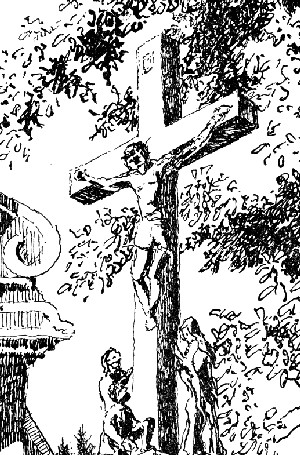
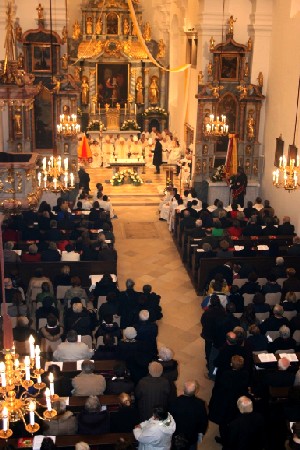 Basilica
Status for Die Kirche des Franziskanerklosters in Güssing: On November 24, 2013, the
Church of the Franciscan Cloister in Güssing was raised to the official status of
Basilica Minor by the Catholic Church. Among the 1600+ Basilicas worldwide, only four
(all in Rome) have a status of Basilica Major, so one should not read the "Minor" as a
slight. All Basilicas are important church buildings so designated by the Pope because they
carry special spiritual, historical, and/or architectural significance. Once named a Basilica,
the church can never lose its status as a Basilica. This is the highest permanent
designation for a church building.
Basilica
Status for Die Kirche des Franziskanerklosters in Güssing: On November 24, 2013, the
Church of the Franciscan Cloister in Güssing was raised to the official status of
Basilica Minor by the Catholic Church. Among the 1600+ Basilicas worldwide, only four
(all in Rome) have a status of Basilica Major, so one should not read the "Minor" as a
slight. All Basilicas are important church buildings so designated by the Pope because they
carry special spiritual, historical, and/or architectural significance. Once named a Basilica,
the church can never lose its status as a Basilica. This is the highest permanent
designation for a church building.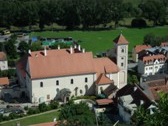 As
for the Church of the Franciscan Cloister (also known as the Kirche Maria Heimsuchung
/ Church of the Visitation of Mary), it was granted Basilica status because it dates
back to the 15th Century, because it houses the royal tomb of the Batthyány family, and because
it houses the oldest library in Burgenland. Further, the building received a major renovation
over the past two years (partly funded by an EU grant of 400,000 euros).
As
for the Church of the Franciscan Cloister (also known as the Kirche Maria Heimsuchung
/ Church of the Visitation of Mary), it was granted Basilica status because it dates
back to the 15th Century, because it houses the royal tomb of the Batthyány family, and because
it houses the oldest library in Burgenland. Further, the building received a major renovation
over the past two years (partly funded by an EU grant of 400,000 euros). 
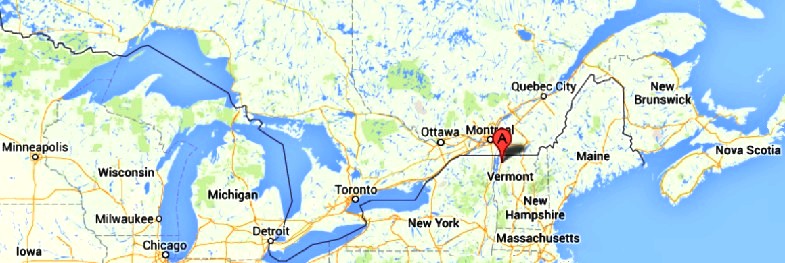
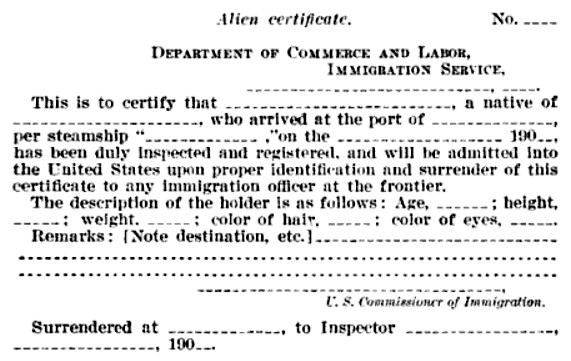 If
admitable to the US, the inspector issued the passenger a "Certificate of Admission"
(aka: Alien Certificate) showing he or she had been inspected and admitted. The
railroads required all passengers who landed in Canada within the last thirty days to present
their Certificates of Admission before boarding a US-bound train. When the train stopped
at the border, a US inspector boarded the train and collected the Certificates of Admission.
In this way, their arrival at a Canadian seaport and their subsequent physical entrance into the
United States were connected.
If
admitable to the US, the inspector issued the passenger a "Certificate of Admission"
(aka: Alien Certificate) showing he or she had been inspected and admitted. The
railroads required all passengers who landed in Canada within the last thirty days to present
their Certificates of Admission before boarding a US-bound train. When the train stopped
at the border, a US inspector boarded the train and collected the Certificates of Admission.
In this way, their arrival at a Canadian seaport and their subsequent physical entrance into the
United States were connected.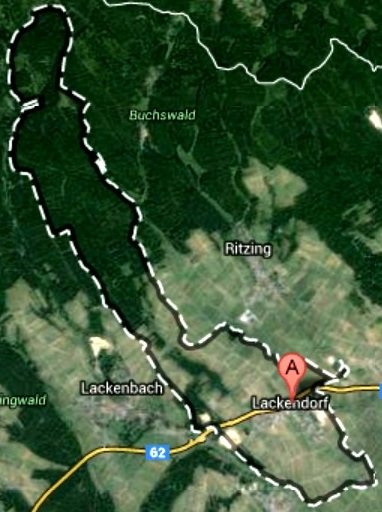 As
a Burgenland comparison, I was able to obtain the 1910 land holdings for Lackendorf,
Burgenland. The raw (tax) data is some of that acquired by Klaus Gerger for the BB Houselists
project.
As
a Burgenland comparison, I was able to obtain the 1910 land holdings for Lackendorf,
Burgenland. The raw (tax) data is some of that acquired by Klaus Gerger for the BB Houselists
project.